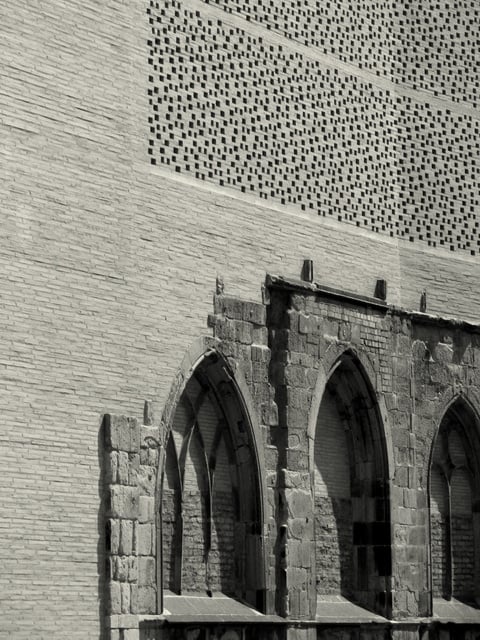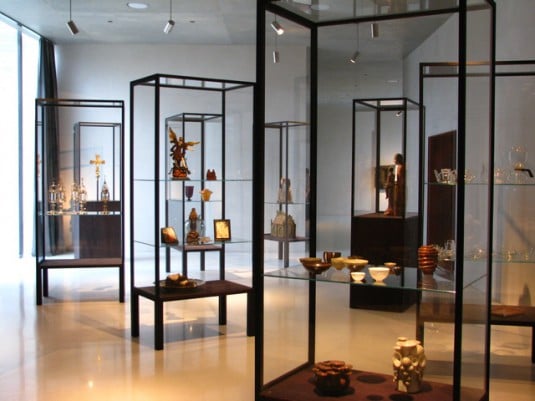
April 8, 2012
Contemplating Art and Religion in Kolumba
As cathedrals were in the middle ages, museums are for today’s architects the grand opportunity for almost unlimited possibilities to create soaring, dramatic, sculptural design. So when the Archdiocese of Cologne decided to build a new museum to house its unique collection, it presented a rare opportunity to link the two architectural paradigms together. Founded […]
As cathedrals were in the middle ages, museums are for today’s architects the grand opportunity for almost unlimited possibilities to create soaring, dramatic, sculptural design. So when the Archdiocese of Cologne decided to build a new museum to house its unique collection, it presented a rare opportunity to link the two architectural paradigms together.
Founded in 1853, the archdiocese museum (opened in 2007), Kolumba, features a collection that combines historic religious art and relics dating back to early Christianity, and a well-curated selection of contemporary art. The site, itself, is rich in architecture history, from Roman ruins to the remains of a cherished Gothic cathedral destroyed during WWII and featuring a Modern chapel (“Madonna in den Trümmern”/ Madonna in the Ruins, 1949) by Gottfried Bohm sheltering a statue of Mary that survived the bombings. How does an architect approach such sensitive theme and site?
The architect chosen couldn’t have been more appropriate for such a project. Swiss architect, Peter Zumthor, a Pritzker honoree known for his exquisite minimalist designs, takes the essentials to a deep, even spiritual level. He responded to the challenge with a building of simple lines and clean geometry, rich in space, materials, and light. Its no-frills shape fits perfectly within its context, establishing a balanced dialogue with the nearby modernist post-war buildings, recently recognized as a symbol of an important time in the city’s history. The layered spaces created within and the materials chosen—these details were seriously considered during the architectural competition–are where the magic happens. The exterior brick walls–light gray and long, horizontal spans—give a contemporary lightness to the building in spite of its sizable footprint. What’s more the wall has a feel of craftsmanship that evokes its historic roots.
These roots were made more explicit by incorporating the original ruins into the main facades. In a city heavily damaged during the war, these ruins were a particularly sensitive topic for many in the community. “I was pleased to see how Zumthor managed to integrate the remains of the old church into a new building that does not try to supersede the past but actually urges us to remember the past while breaking path for the future,” says Dr. Michael-Lysander Fremuth, an assistant professor of international law and a long time resident of Cologne.
The brick also serves as a creative resource to shelter the Rohm chapel and its engaging lighting—intermittent layering creates a lacy effect of filtered daylight. The soft illumination shows sensitivity to an area that requires careful light controls because of the archeological excavations adjacent to the chapel, at ground level. The chapel, though situated within the main building, functions independently from the museum, almost as if it were one more oversized item in the museum’s collection.
Inside, all the elements come together to express the museum’s mission as a “place of contemplation.” In the galleries there are a variety of scales and light conditions to be experienced. Walls are finished with smooth clay plaster, the floors in Jura limestone and terrazzo, creating the neutral background required for such a setting. Here and there, large openings extend the contemplation to include the city, with a respectful bow towards the DOM (Cologne’s Cathedral and Unesco-designated historic monument).
Zumthor’s design manages to embrace the museum’s philosophical concepts of beauty, order, the continuum of past/present, art, the individual, and faith. The result is a real “place.” And in this place time is in constant motion through the ages, yet it is “in the moment,” and still enough for introspection—quite fitting for today as the Catholic Church searches for ways to appeal to the changing definition of the “faithful.” Kolumba, the museum and its design, sends an important message: Being actively open to the new is the best way to respect our humanity and value history and tradition.
All photos by Paul Clemence
Paul Clemence is an award-winning photographer whose work is part of many collections, including the Mies van der Rohe’s Archives and house by MoMa, New York. He exhibits both in the US and on the international fine art circuit, from classic B & W prints to large scale photo installations. A published author, his work can also be seen in major design and lifestyle publications. His “Architecture Photography” Facebook page (www.facebook.com/archi.photo) receives over half a million hits monthly.











